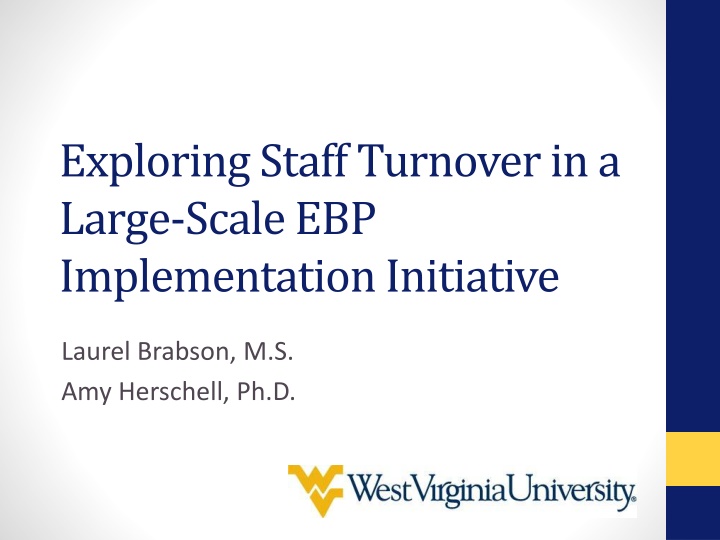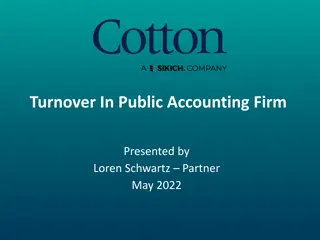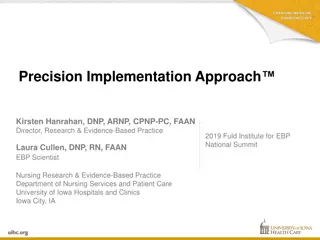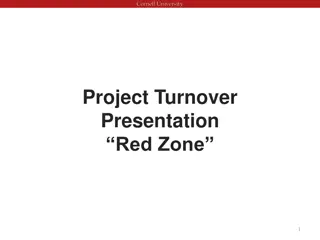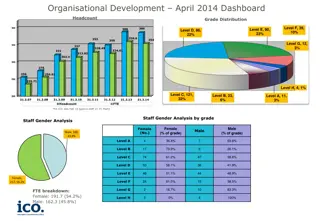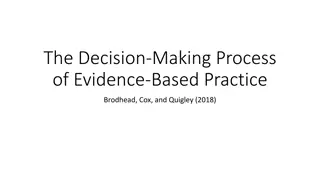Staff Turnover in Large-Scale EBP Implementation
Investigating staff turnover in the context of a large-scale Evidence-Based Practice (EBP) implementation initiative, exploring predictors, conceptual models, limitations within literature, and findings from a current study focusing on 12-month training periods and 24-month data collection periods.
Download Presentation

Please find below an Image/Link to download the presentation.
The content on the website is provided AS IS for your information and personal use only. It may not be sold, licensed, or shared on other websites without obtaining consent from the author.If you encounter any issues during the download, it is possible that the publisher has removed the file from their server.
You are allowed to download the files provided on this website for personal or commercial use, subject to the condition that they are used lawfully. All files are the property of their respective owners.
The content on the website is provided AS IS for your information and personal use only. It may not be sold, licensed, or shared on other websites without obtaining consent from the author.
E N D
Presentation Transcript
Exploring Staff Turnover in a Large-Scale EBP Implementation Initiative Laurel Brabson, M.S. Amy Herschell, Ph.D.
Acknowledgments Amy Herschell WVU Implementation Science Group PCIT Across PA Research Team Chris Owens, Jon Hart, and Shelley Hiegel Funding source: NIMH R01 MH095750; A Statewide Trial to Compare Three Training Models for Implementing an EBT; PI: Herschell
Turnover Definition: The separation of an employee from an organization Professions with high rates of annual turnover Teachers: 11% (Ingersoll, 2001) Nurses: 14% (Gray & Phillips, 1994) Behavioral Health Staff: 30-50%
Conceptual Model Lambert, Hogan, & Barton (2001)
Predictors of Turnover Demographic Organizational Culture Age Climate Education Work Attitudes Salary Service Structure Agency Size
Predictors of Turnover Organizational Culture Norms and expectations for how things are done within the work environment Constructive vs. defensive Rigid, proficient, resistant Organizational Climate Employee attitudes toward and perceptions of the work environment Job satisfaction, fairness, emotional exhaustion, role clarity, etc. Engaged, functional, stressful
Limitations within Literature Definition of Turnover Voluntary vs. Involuntary Change role within same organization Different time periods Focus almost exclusively on direct service providers
Current Study Actual Turnover 12-month training period 24-month data collection period Clinician, Supervisor, Administrator
Parent Study PCIT Across PA (NIMH R01 MH095750; PI: Herschell) State-wide implementation of an EBP in community settings Effectiveness of three different training models
Parent Study Training Models Cascading Model Learning Collaborative Distance Education
Parent Study Training Models Cascading Model Learning Collaborative Distance Education
Parent Study Training Models Cascading Model Learning Collaborative Distance Education
Current Study Aims A. Explore rates of staff turnover within the parent study B. Identify predictors of turnover for clinicians and for supervisors/administrators
Methods: Procedure Agency Enrollment N = 50 psychiatric outpatient clinics in Pennsylvania Staff Enrollment N = 1 administrator, 1 supervisor, 2 clinicians Randomization Randomization to training condition based on county
Methods: Measures Background Form Agency Staff Change Form Organizational Readiness for Change (Lehman, Greener, & Simpson, 2002) supervisors & administrators 115 items, 1-5 point Likert-type scale Cronbach's alpha > .70 for subscales Survey of Organizational Functioning Clinicians 162 items, 1-5 point Likert-type scale
Methods: Analyses 12- and 24- month rates of turnover were calculated Chi-square tests to compare rates of turnover Logistic regression to identify demographic predictors Age Tenure with agency Salary Hierarchical Linear Modeling (HLM) to identify organizational predictors Organizational culture Organizational climate
Results Sample Characteristics 100 clinicians 91% Caucasian 84% female 92% Masters degree 39 years old (SD = 10.04) 50 administrators 90% Caucasian 62% female 68% Masters degree 48 years old (SD = 8.96) 50 supervisors 88% Caucasian 80% female 82% Masters degree 45 years old (SD = 9.48)
Results Rates of Turnover 12 Month 24 Month N (%) N (%) Full Sample 16 (8.0%) 59 (29.5%) Clinicians 11 (11.0%) 31 (31.0%) Supervisors 3 (6.0%) 15 (30.0%) Administrators 2 (4.0%) 13 (26.0%)
Results Rates of Turnover 12 Month 24 Month N (%) N (%) Full Sample 16 (8.0%) 59 (29.5%) Clinicians 11 (11.0%) 31 (31.0%) Supervisors 3 (6.0%) 15 (30.0%) Administrators 2 (4.0%) 13 (26.0%)
Results Rates of Turnover 12 Month 24 Month N (%) N (%) Full Sample 16 (8.0%) 59 (29.5%) Clinicians 11 (11.0%) 31 (31.0%) Supervisors 3 (6.0%) 15 (30.0%) Administrators 2 (4.0%) 13 (26.0%)
Results Turnover by Training Condition 12 Month 24 Month N (%) N (%) LC CM DE LC CM DE Full Sample 4 (6.3%) 3 (4.7%) 9 (13.2%) 25 (41.7%) 14 (21.9%) 20 (29.9%) Clinicians 2 (6.7%) 3 (9.4%) 6 (17.6%) 10 (33.3%) 32 (28.1%) 33 (36.4%) Supervisors 1 (5.9%) 0 (0.0%) 2 (11.8%) 8 (53.3%) 3 (18.8%) 4 (23.5%) Administrators 1 (5.9%) 0 (0.0%) 1 (5.9%) 7 (46.7%) 2 (12.5%) 4 (23.5%) LC Learning Collaborative; CM Cascading Model; DE Distance Education
Results Turnover by Training Condition 12 Month 24 Month N (%) N (%) LC CM DE LC CM DE Full Sample 4 (6.3%) 3 (4.7%) 9 (13.2%) 25 (41.7%) 14 (21.9%) 20 (29.9%) Clinicians 2 (6.7%) 3 (9.4%) 6 (17.6%) 10 (33.3%) 32 (28.1%) 33 (36.4%) Supervisors 1 (5.9%) 0 (0.0%) 2 (11.8%) 8 (53.3%) 3 (18.8%) 4 (23.5%) Administrators 1 (5.9%) 0 (0.0%) 1 (5.9%) 7 (46.7%) 2 (12.5%) 4 (23.5%) LC Learning Collaborative; CM Cascading Model; DE Distance Education
Results Turnover by Training Condition 12 Month 24 Month N (%) N (%) LC CM DE LC CM DE Full Sample 4 (6.3%) 3 (4.7%) 9 (13.2%) 25 (41.7%) 14 (21.9%) 20 (29.9%) Clinicians 2 (6.7%) 3 (9.4%) 6 (17.6%) 10 (33.3%) 32 (28.1%) 33 (36.4%) Supervisors 1 (5.9%) 0 (0.0%) 2 (11.8%) 8 (53.3%) 3 (18.8%) 4 (23.5%) Administrators 1 (5.9%) 0 (0.0%) 1 (5.9%) 7 (46.7%) 2 (12.5%) 4 (23.5%) LC Learning Collaborative; CM Cascading Model; DE Distance Education
Results Turnover by Training Results Aim 1 Condition 12 Month 24 Month N (%) N (%) LC CM DE LC CM DE Full Sample 4 (6.3%) 3 (4.7%) 9 (13.2%) 25 (41.7%) 14 (21.9%) 20 (29.9%) Clinicians 2 (6.7%) 3 (9.4%) 6 (17.6%) 10 (33.3%) 32 (28.1%) 33 (36.4%) Supervisors 1 (5.9%) 0 (0.0%) 2 (11.8%) 8 (53.3%) 3 (18.8%) 4 (23.5%) Administrators 1 (5.9%) 0 (0.0%) 1 (5.9%) 7 (46.7%) 2 (12.5%) 4 (23.5%) LC Learning Collaborative; CM Cascading Model; DE Distance Education
Results Turnover by Training Condition 12 Month 24 Month N (%) N (%) LC CM DE LC CM DE Full Sample 4 (6.3%) 3 (4.7%) 9 (13.2%) 25 (41.7%) 14 (21.9%) 20 (29.9%) Clinicians 2 (6.7%) 3 (9.4%) 6 (17.6%) 10 (33.3%) 32 (28.1%) 33 (36.4%) Supervisors 1 (5.9%) 0 (0.0%) 2 (11.8%) 8 (53.3%) 3 (18.8%) 4 (23.5%) Administrators 1 (5.9%) 0 (0.0%) 1 (5.9%) 7 (46.7%) 2 (12.5%) 4 (23.5%) LC Learning Collaborative; CM Cascading Model; DE Distance Education
Results Turnover by Training Condition 12 Month 24 Month N (%) N (%) LC CM DE LC CM DE Full Sample 4 (6.3%) 3 (4.7%) 9 (13.2%) 25 (41.7%) 14 (21.9%) 20 (29.9%) Clinicians 2 (6.7%) 3 (9.4%) 6 (17.6%) 10 (33.3%) 32 (28.1%) 33 (36.4%) Supervisors 1 (5.9%) 0 (0.0%) 2 (11.8%) 8 (53.3%) 3 (18.8%) 4 (23.5%) Administrators 1 (5.9%) 0 (0.0%) 1 (5.9%) 7 (46.7%) 2 (12.5%) 4 (23.5%) LC Learning Collaborative; CM Cascading Model; DE Distance Education
Results Predictors Demographic Variables Age Tenure with agency Salary Organizational Variables Culture Climate
Results Predictors Demographic Predictors Clinicians Logistic regression including age, salary, and tenure not significant Supervisors and Administrators Logistic regression including age and tenure not significant
Results Predictors Organizational Predictors Clinicians Organizational culture and climate not significant predictors of turnover Supervisor and Administrator Organizational culture not a significant predictor Organization climate was a significant predictor Both with and without training condition included
Discussion Lower 12-month rate, comparable 24-month Protective effect of EBPs Turnover after training completion Effect of training method on higher-level staff Organizational climate may be related to training condition for supervisors and administrators
Limitations Study not designed specifically to assess turnover Nesting Small sample size vs. need for complex analyses Variable selection
Implications and Future Directions Awareness of the impact of training model on more than just clinician knowledge and skill Assess organizational climate prior to EBP implementation Inclusion of staff other than direct service providers Macro-level analysis
Implications and Future Directions
References Aarons, G. A., & Sawitzky, A. C. (2006). Organizational climate partially mediates the effect of culture on work attitudes and staff turnover in mental health services. Administration and Policy in Mental Health, 33(3), 289 301. http://doi.org/10.1007/s10488-006-0039-1 Aarons, G. A., Sommerfeld, D. H., & Willging, C. E. (2011). The soft underbelly of system change: The role of leadership and organizational climate in turnover during statewide behavioral health reform. Psychological Services, 8(4), 269. http://dx.doi.org/10.1037/a0026196 Adair, C. E., McDougall, G. M., Mitton, C. R., Joyce, A. S., Wild, T. C., Gordon, A., Beckie, A. (2005). Continuity of care and health care costs among persons with severe mental illness. Psychiatric Services (Washington, D.C.), 56(9), 1070 1076. http://doi.org/10.1176/appi.ps.56.9.1070 Ben-Dror, R. (1994). Employee turnover in community mental health organization: A developmental stages study. Community Mental Health Journal, 30(3), 243 257. Beidas, R. S., Marcus, S., Wolk, C. B., Powell, B., Aarons, G. A., Evans, A. C., Mandell, D. S. (2015). A prospective examination of clinician and supervisor turnover within the context of implementation of evidence-based practices in a publicly-funded mental health system. Administration and Policy in Mental Health. http://doi.org/10.1007/s10488-015-0673-6 Bjorklund, R. W., Monroe-DeVita, M., Reed, D., Toulon, A., & Morse, G. (2009). Washington State s initiative to disseminate and implement high-fidelity ACT teams. Psychiatric Services, 60(1), 24 27. http://doi.org/10.1176/appi.ps.60.1.24 Bukach, A. M., Ejaz, F. K., Dawson, N., & Gitter, R. J. (2015). Turnover among community mental health workers in ohio. Administration and Policy in Mental Health and Mental Health Services Research. http://doi.org/10.1007/s10488-015-0706-1 Cyphers, G. (2001). Report from the child welfare workforce survey: State and county data and findings. Washington, DC: American Public Human Services Association.
References Glisson, C., Schoenwald, S. K., Kelleher, K., Landsverk, J., Hoagwood, K. E., Mayberg, S., & Green, P. (2008). Therapist Turnover and New Program Sustainability in Mental Health Clinics as a Function of Organizational Culture, Climate, and Service Structure. Administration and Policy in Mental Health and Mental Health Services Research, 35(1-2), 124 133. http://doi.org/10.1007/s10488-007-0152-9 Gray, A. M., & Phillips, V. L. (1994). Turnover, age and length of service: a comparison of nurses and other staff in the National Health Service relationship to the age and length of service characteristics of the labour force. Journal of Advanced Nursing, 19(4), 819 827. http://doi.org/10.1111/j.1365- 2648.1994.tb01155.x Iglehart, A. P. (1990). Turnover in the social services: turning over to the benefits. Social Service Review, 649 657. Ingersoll, R. M. (2001). Teacher Turnover and Teacher Shortages : An Organizational Analysis. American Educational Research Journal, 38(3), 499 534. http://doi.org/10.3102/00028312038003499 Knudsen, H. K., Johnson, J. A., & Roman, P. M. (2003). Retaining counseling staff at substance abuse treatment centers: Effects of management practices. Journal of Substance Abuse Treatment, 24(2), 129-135. Lambert, E. G., Hogan, N., & Barton, S. M. (2001). The impact of job satisfaction on turnover intent: A test of a structural measurement model using a national sample of workers. Social Science Journal, 38(2), 233 250. http://doi.org/10.1016/S0362-3319(01)00110-0 Sheidow, A. J., Schoenwald, S. K., Wagner, H. R., Allred, C. a, & Burns, B. J. (2007). Predictors of workforce turnover in a transported treatment program. Administration and Policy in Mental Health, 34(1), 45 56. http://doi.org/10.1007/s10488-006-0061-3
Supervisor Turnover Administrator Turnover 100 100 90 90 80 80 70 70 60 60 LC CM DE LC CM DE 50 50 40 40 30 30 20 20 10 10 0 0 12 Month 24 Month 12 Month 24 Month Note: LC Learning Collaborative; CM Cascading Model; DE Distance Education
Cliniciansa n (%) Supervisorsb n (%) Administratorsc n (%) Gender Male Female Race African American Asian Caucasian Native American/Alaska Native Native Hawaiian/Pacific Islander Not Reported Ethnicity Hispanic/Latino Not Hispanic/Latino 19 (38.0%)*a,b 31 (62.0%) 16 (16.0%) 84 (84.0%)*c 10 (20.0%) 40 (80.0%)*c 5 (5.0%) 1 (1.0%) 91 (91.0%) 3 (3.0%) 3 (3.0%) 3 (3.0%) 3 (6.0%) 0 (0.0%) 44 (94.0%) 0 (0.0%) 0 (0.0%) 0 (0.0%) 1 (2.0%) 1 (2.0%) 45 (90.0%) 0 (0.0%) 0 (0.0%) 3 (6.0%) 8 (8.0%) 92 (92.0%) M (SD) 39.04 (10.04) 44.77 (9.48)+a 11.42 (8.20) 4.82 (5.61) 5 (10.0%) 45 (90.0%) M (SD) 3 (6.0%) 47 (94.0%) M (SD) 48.51 (8.86)+a 22.18 (8.53)+a 11.55 (8.40)+a Age Years in human services industry Years at agency 18.26 (8.60)+a 7.20 (5.45)+a Note: *p < 0.05; +p <0.01
Cliniciansa Supervisorsb Administratorsc Education Level Some college 0 (0.0%) 0 (0.0%) 2 (4.0%) Bachelor s degree 0 (0.0%) 0 (0.0%) 2 (4.0%) Some graduate work 0 (0.0%) 0 (0.0%) 1 (2.0%) 92 (92.0%)*b,c Master s degree 41 (82.0%) 34 (68.0%) Doctoral degree 8 (8.0%) 9 (18.0%) 10 (20.0%) Degree Type Education 2 (2.0%) 4 (8.0%) 3 (6.0%) Medicine 4 (4.0%) 1 (2.0%) 3 (6.0%) Psychology 37 (37.0%) 16 (32.0%) 11 (22.0%) Social Work 31 (31.0%) 18 (36.0%) 16 (32.0%) Other 26 (26.0%) 11 (22.0%) 15 (30.0%) Condition Learning Collaborative 34 (34.0%) 17 (34.0%) 17 (34.0%) Cascading Model 32 (32.0%) 16 (32.0%) 16 (32.0%) Distance Education 34 (34.0%) 17 (34.0%) 17 (34.0%) Assessment Method Online 86 (86.0%) 73 (86.0%) n/a Paper 14 (14.0%) 7 (14.0%) n/a Note: *p < 0.05; +p <0.01
Children n (%) Parents n (%) Gender Male Female Race African American Asian Caucasian Native American/Alaska Native Native Hawaiian/Pacific Islander Not Reported Ethnicity Hispanic/Latino Not Hispanic/Latino Relationship to Child Biological Mother Biological Father Adoptive Mother Grandmother 67 (61.0%) 43 (39.0%) 4 (3.6%) 106 (96.4%) 28 (25.5%) 1 (0.9%) 75 (68.1%) 3 (2.7%) 0 (0.0%) 3 (2.7%) 28 (25.5%) 1 (0.9%) 75 (68.1%) 3 (2.7%) 0 (0.0%) 3 (2.7%) 15 (13.6%) 95 (86.4%) 14 (12.7%) 96 (87.3%) -- -- -- -- 99 (90.0%) 4 (3.6%) 4 (3.6%) 3 (2.7%)
Children n (%) Parents n (%) Education Less than high school Some high school High school graduate/GED Some college Associate degree Bachelor s degree Graduate/professional education Did not report Household Income $14,999 or less $15,000 to $29,999 $30,000 to $49,999 $50,000 to $74,999 $75,000 or more Did not report -- -- -- -- -- -- -- 8 (7.3%) 14 (12.7%) 35 (31.8%) 18 (16.4%) 9 (8.2%) 6 (5.5%) 10 (9.1%) 10 (9.1%) -- -- -- -- -- 42 (38.1%) 22 (20.0%) 8 (7.3%) 6 (5.5%) 9 (8.2%) 23 (20.9%) Age M (SD) 5.26 (1.63) M (SD) 32.29 (8.18)
Clinicians (n = 100) Variables 1. Age M (SD) 39.04 (10.04) 1 -- 2 3 4 5 2. Salary 45,039 (11,574) 0.41** -- 3. Tenure w/agency 4.82 (5.61) 0.32** 0.20 -- 4. Org. Climate 34.53 (4.90) 0.15 -0.13 0.33** -- 5. Org. Culture 34.17 (5.52) 0.13 -0.15 0.20* 0.73** -- Supervisors and Administrators (n = 100) M (SD) 46.62 (9.37) 1 -- 2 3 4 1. Age 2. Tenure w/agency 9.35 (7.36) 0.37** -- 3. Org. Climate 37.02 (3.68) 0.07 0.05 -- 4. Org. Culture 37.00 (4.15) 0.09 0.08 0.56** -- *p < 0.05, **p < 0.01
Training Conditions Cascading Model aka train the trainer 2 clinicians trained, become trainer for others at their clinic 40 hours of face-to-face training 16 hours of live training with real cases for 6 months Bi-weekly consultation calls for 12 months Learning Collaborative 2 clinicians, 1 supervisor, 1 administrator 3 month pre-work phase 9 month learning sessions Action periods in between learning sessions included consultation calls Distance Education 11 modules with various components Took approximately 10 hours to complete PCIT Manual, DPICS manual, DPICS workbook Consultation calls with a trainer
Cascading Model 2 clinicians trained, become trainer for others at their clinic 40 hours of face-to-face training 16 hours of live training with real cases for 6 months Bi-weekly consultation calls for 12 months
Learning Collaborative 2 clinicians, 1 supervisor, 1 administrator 3 month pre-work phase 9 month learning sessions Action periods in between learning sessions included consultation calls
Distance Education 11 modules with various components Took approximately 10 hours to complete PCIT Manual, DPICS manual, DPICS workbook Consultation calls with a trainer
Organizational Readiness for Change 115 items 1-5 Likert-type scale Main Scales Motivational Factors program needs, training needs, pressures for change Program Resources office facilities, staffing, training, equipment, internet Staff Attributes growth, efficacy, influence, adaptability, satisfaction Organizational Climate mission, cohesion, autonomy, communication, stress, change, leadership
Survey of Organizational Functioning (SOF) 162 items 1-5 Likert-type scale Main Scales Change program needs, training needs, pressures for change Resources offices, staffing, training, computer access, e- communications Staff Attributes growth, efficacy, influence, adaptability Organizational Climate mission, cohesion, autonomy, communication, stress, change Job Attitudes burnout, satisfaction, director leadership Workplace Practices peer collaboration, deprivatized practice, collective responsibility, focus on outcomes, reflective dialogue, counselor socialization Training Exposure and Utilization training satisfaction, training exposure, training utilization-individual, training utilization-program level
